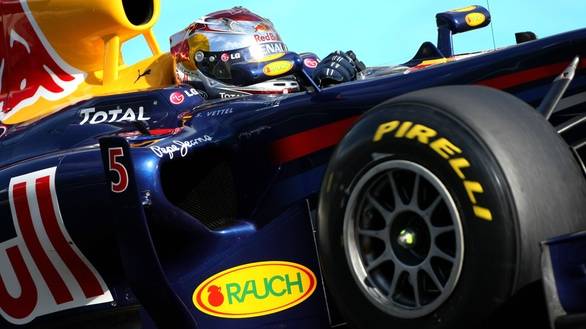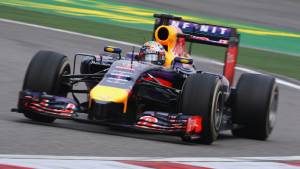2014 F1 regulations explained
This year you'll hear a lot about how the 2014 regulations for Formula 1 are going to be a huge change. What exactly are the changes? I'll divide it into two parts the engine and the chassis.
 Come 2014, F1 cars aren't likely to look quite the same as this one
Come 2014, F1 cars aren't likely to look quite the same as this one
After three years of discussions, planning and development, the most significant technical change to hit the sport in more than two decades is introduced. Going away from the current 2.4-litre non-turbo V8, engine regulations form the major part of the coming revolution with the idea being to create an engine platform closer to what is being used in the 'real world' of road cars which would perhaps tempt more manufacturers to come in to F1.
Next year will see the introduction of a new generation of Power Units that combine a 1.6-litre V6 turbocharged engine with energy recovery systems that will dramatically increase efficiency by harvesting energy dissipated as heat in the exhaust or brakes. One of the great challenges of the new Power Unit is to reduce the turbo-lag to near zero to match the instant torque delivery of the current V8 engines and improve driveability.
The maximum power of the new Power Unit will exceed the output of current V8 F1 engines, yet fuel efficiency will be radically improved. The fuel quantity for the race is now limited to 100kg but the new units will use 35 per cent less fuel than their predecessors. Potent Energy Recovery Systems (ERS) are allowed that will assist this efficiency by a huge amount. Compared to 2013 KERS, the ERS of the 2014 Power Unit will have twice the power (120 kW vs 60 kW) and a performance effect 10 times greater. There are several ways for the engine manufacturers to use this energy, but quite simply, they could either use it to charge the batteries or to use it in a more direct efficient way for power. Renault for example have talked about using two separate units as generators one connected to the crankshaft and another connected to the turbocharger.
For 2014, the fuel flow is limited to 100 kg/hr, and the fuel quantity for the race to 100kg. So if the car uses fuel at the maximum permitted rate of 100 kg/hr, it can do so for only 1 hour. Performance is intended to be similar to 2013, so in fact the races will last more like 1hr 30min. Of course the circuit and car characteristics will not allow the cars to run at maximum power all through. It is predicted that the natural fuel consumption for the race distance will be close to the allowed 100kg.
The electronic engine and energy management systems will have a huge role to play next year. The energy management system ostensibly decides when and how much fuel to take out of the tank and when and how much energy to take out or put back in to the battery. The question then becomes where to deploy the energy in the lap. This season, KERS is used only a few places in a lap. But from 2014 all of the energy, from fuel and battery, is so precious that the teams will have to identify where deployment will be beneficial over the whole lap and saving will be least harmful for lap time a form of 'power scheduling'.
There are quite a few components which will be directly or indirectly controlled by the energy management system; namely the internal combustion engine, the turbo, the ERS-K, ERS-H, battery and braking system. Each has their own requirement at any given time, for example the operating temperature limit. There can also be many different energy paths between those components. As a result, the control algorithm can be quite complex to develop and manage. As much energy as possible, which would otherwise be wasted, will be recovered and put back into the car system. It would not be an over-estimation to state that the F1 cars of next year are probably the most fuel and energy efficient machines on the road.
With the 2014 Power Unit, the V6 turbocharged engine will be a minimum of 145kg, plus 35kg for the battery. At 180kg, this is an 80 per cent increase over the current units, plus a further 20kg for the ancillaries such as the intercooler and other radiators. To counter this, the FIA have decided that the overall car weight goes up from 642kg to 690kg.
This brings us nicely on to the chassis side of things. The Power Unit is much more integrated and central to design, for example the turbo overlaps the gearbox so it intrudes into the space where there was a clutch or a suspension part. The energy store is also much larger, which has an impact on chassis length, fuel volume and radiator position. The regulations also have gone away from the twin exhausts to a single tail pipe of fixed dimensions which will take away all this Coanda/blown floor effect.
There are huge changes to the aero regulations with the front of the chassis and the front of the nosebox being lowered in combination with a narrower front wing for safety reasons to prevent disastrous T-bone or nose-to-wheel crashes. On the rear wing, the lower beam wing has been banned and the top flap will be a bit shallower. All of this will have an effect of lower downforce in general and put further emphasis on the power units for performance and laptime.
How will all this affect the racing ? Well, we'll have to wait and see! The changes to the engine rules have come at a huge cost (some companies talking about around 150 million Euro) and typically a wholesale change in regulation will see bigger differences between teams. Mercedes and Renault have more experience with energy recovery systems than Ferrari and I do feel that this may help them in the early stages. The smart ones though could be Honda who are spending a year on the sidelines testing away without having the distraction of racing a current engine before arriving in 2015. Fascinating times await !
Related Stories
Top Stories
Latest Videos
Most Popular
- Budget Sportbike Showdown: Kawasaki Ninja 500 vs Aprilia RS 457 vs Yamaha YZF-R3
- 2014 Triumph Daytona 675 vs 2024 Kawasaki ZX6R - A Decade of Evolution in Supersport Motorcycles
- Mumbai-Pune Expressway speed restrictions updated
- Nissan Magnite EZ-Shift review - is the AMT any good?
- Nitin Gadkari states that tax on Hybrids should be reduced to 12 percent in the coming future













